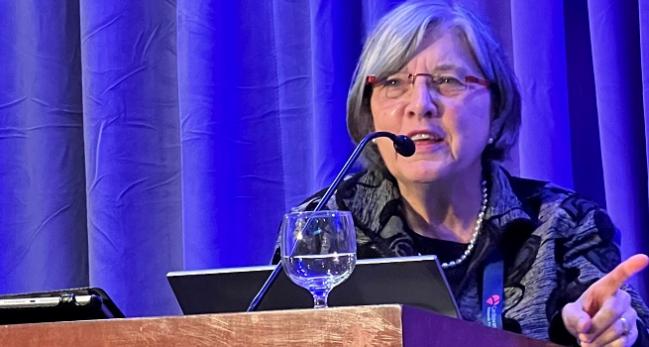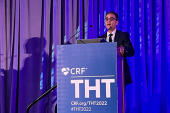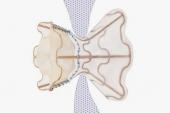Early Positive Signals From RELIEVE-HF Shift Discussion to Atrial Shunt Size
Nonrandomized QoL data from a roll-in cohort hint at an effect, but whether shunt size proves important needs more data.

One day after the release of the disappointing results from the REDUCE LAP-HF II trial, testing an atrial shunt in heart failure with midrange or preserved ejection fraction (HFmrEF and HFpEF), a second trial using a different device in a broader swath of HF patients is offering a glimmer of hope.
The randomized RELIEVE-HF trial is testing the Ventura Interatrial Shunt (V-Wave) in patients with symptomatic HF across the full spectrum of ejection fraction, from reduced (HFrEF) to HFpEF. The study is still underway at 120 sites internationally but today, during a late-breaking session at the Technology and Heart Failure Therapeutics (THT) 2022 meeting in New York, JoAnn Lindenfeld, MD (Vanderbilt University Medical Center, Nashville, TN), presented an unblinded snapshot of the “roll-in” cohort. RELIEVE-HF is planned as a 400-patient trial but includes an expansion plan based on an interim analysis that could lead to 1,000 randomized participants.
“We were all a bit disappointed yesterday when we heard the results of REDUCE LAP-HF II,” she acknowledged at the start of her talk. But there may be important differences between the devices and the trial designs that give reason for optimism, she said. Back in October 2021, during a planned interim analysis by RELIVE-HF’s data safety and monitoring board, the recommendation was to “continue the trial as planned,” she noted. More than 350 patients have been enrolled to date. “So not futile,” she said. “Let's not get too depressed here. There's some data to say: let's not get too worried yet.”
Early Results
As Lindenfeld showed today, among the first 97 patients to be enrolled, investigators are seeing high implantation success rates and safety, as well as sustained improvements in quality of life. The shunt device was successfully implanted in all but one patient, with no device embolizations or dislocations. Shunt patency through 12 months—an issue that arose among patients in an earlier feasibility trial with a prior iteration of this device—was 100%.
Let's not get too depressed here. There's some data to say: let's not get too worried yet. JoAnne Lindenfeld
Roll-in patients reported significant improvements in change in Kansas City Cardiomyopathy Questionnaire (KCCQ) scores from baseline that emerged in the first month and were sustained out to 12 months, with more than two-thirds reporting improvements of 5 points or greater and with gains seen among both HFrEF and HFpEF patients. Roughly half of all patients also experienced improvements in NYHA class, regardless of baseline ejection fraction.
“Preliminary observations demonstrate potential for improvement in symptoms—quality of life, NYHA class—in both HFrEF and HFpEF patients,” Lindenfeld concluded.
Seeking Explanations
Towards the end of her talk, Lindenfeld stressed what she believes are some of the important differences between the trials apart from the broader range of EF being studied in RELIEVE-HF. These include intensity of guideline-directed medical therapy, duration of HF, baseline hemodynamic measurements, and different criteria for determining left atrial overload.
During yesterday’s THT 2022 session devoted to atrial shunts, Barry Borlaug, MD (Mayo Clinic, Rochester, MN), made the case that atrial shunts may be harmful in patients with latent pulmonary vascular disease (PVD) on an invasive exercise test but beneficial in HFpEF patients without PVD, as defined by exercise pulmonary vascular resistance lower than 1.8 Wood units.
For Lindenfeld, a key, possibly related factor may be the size of the shunts produced by the different devices: 5.1 mm for V-Wave in RELIEVE-HF and 8 mm for the Corvia device in REDUCE LAP-HF II.
Following her presentation, Gregg Stone, MD (Icahn School of Medicine at Mount Sinai, New York, NY), co-PI for RELIEVE-HF with Lindenfeld, observed that “we heard a lot about latent pulmonary vascular disease” yesterday in addition to seeing clear signals that PVD patients may see more harm than benefit with shunt implantation. He put the question to Lindenfeld as to whether the PVD signal tracks with the larger shunt size and greater flow that this would permit.
“I do think that if the RV is overloaded, more flow would be worse, and a maybe a little bit of flow at a time could reduce pulmonary vascular resistance, so you get there more slowly and maybe it's too much too fast [with a larger shunt]. That's one possibility,” Lindenfeld responded. “I think that it makes good sense that a little bit less flow may be better.’
Panelist Anu Lala, MD (Icahn School of Medicine at Mount Sinai), agreed. “I think with increased flow to the right side, we can expect more systemic congestion, and I think that oftentimes what brings patients in is worsening lower extremity edema, a feeling of abdominal bloating and early satiety, and other things. So to me, it's not a surprise, frankly, and know it remains to be seen what will happen [in the larger trial], but I think that the concept of less flow causing potentially less harm or manifestation makes sense.”
Commenting on RELIEVE-HF, on the background of yesterday’s REDUCE LAP-HF II results, Ulrich P. Jorde, MD (Montefiore Medical Center, Bronx, NY), pointed out that the degree of improvement in KCCQ in today’s roll-in cohort is actually “numerically in line with results of REDUCE LAP-HF II, with the delta slightly higher (15 vs 5) in the unblinded roll-in cohort.”
But much of the work for this field still lies ahead, he suggested. “Whether the Corvia shunt may relieve the burden of heart failure in phenotypic subgroups, or whether different size [or] type shunts may be effective in all or some patients, remains to be investigated and requires prospective study,” he said in an email to TCTMD. “The journey continues, but we are one step ahead.”
Shelley Wood was the Editor-in-Chief of TCTMD and the Editorial Director at the Cardiovascular Research Foundation (CRF) from October 2015…
Read Full BioSources
Lindenfeld J, Rodés-Cabau J, Abraham W. Interatrial shunting in chronic heart failure: results from the RELIEVE-HF roll-in cohort. Presented at: THT 2022. New York, NY. February 3, 2022.
Disclosures
- Lindenfeld reports personal consulting fees/honoraria/speakers bureau payments from Abbott Vascular, AstraZeneca, Edwards Lifesciences, Boston Scientific Corporation, St. Jude Medical, Boehringer Ingelheim, Vwave, CVRx, Impulse dynamics, Merck/Schering Plough, and institutional grant support/research contracts from AstraZeneca.





Comments